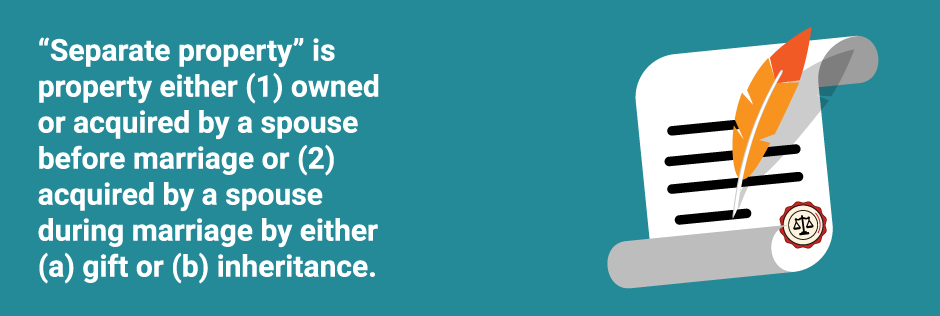Chapter 4: Issues in Divorce
This section covers the basic issues involved in a typical divorce case. If you have no children, you can skip the section below regarding children. Otherwise, you should read each section very carefully and return to this section throughout your case if you have any questions regarding these issues. Remember that in Texas, the court cannot grant a divorce without disposing of property issues. Additionally, if children were born to or adopted during the marriage, orders concerning their conservatorship (custody) and support will be determined at the same time.
Grounds for Divorce
A divorce may be granted on one or more “fault” or “no fault” grounds expressly set out in the Texas Family Code. Most divorces are founded on the no-fault ground of “in supportability” (i.e. incompatibility), which can be granted to either spouse if that spouse feels that the marriage has become insupportable because of discord or conflict in personalities which makes any reasonable expectation of reconciliation impossible.

In that a court may consider “fault” in the breakup of a marriage as a factor in deciding how to divide the property and debts, a party may choose to plead a “fault” ground for divorce. “Fault” grounds for divorce include:
- adultery
- cruel treatment
- conviction of a felony
- abandonment
- living separate and apart for three years
- confinement in a mental hospital
Domicile and Residence
At least one spouse must have been “domiciled” in Texas for six months, and a “resident” of the county where the suit is filed for ninety days, before the petition may be filed. The terms “domicile” and “residence” have different legal meanings, which can be explained to you if need be.

Property and Debts
This subsection is an elementary discussion of some basic rules underlying Texas marital property law.
Types of Property
In the context of divorce law in Texas, all property, both real and personal, is characterized as two different types of property; (1) “separate property” and (2) “community property.”
Separate Property
“Separate property” is property either (1) owned or acquired by a spouse before marriage or (2) acquired by a spouse during marriage by either (a) gift or (b) inheritance. It is the date of acquisition and the source of the property that controls, not how it is eventually paid for. For example, if one spouse owned a house or car before marriage, it will be characterized at the time of divorce as that spouse’s separate property, even if it was paid off in whole or in part during the marriage.
A gift includes, for example, any Christmas or birthday gifts from one spouse to another during the marriage (even if purchased with community funds). If a gift or inheritance goes to both spouses (e.g., wedding gifts), then each spouse has an undivided fifty percent interest in that one piece of separate property.
Separate property can change forms without changing its character as property (this is often referred to as a “mutation”). For example, if a wife has $5,000 in cash which is her separate property and uses that $5,000 cash alone to purchase outright a $5,000 boat, then the boat would likewise be her separate property.
A court has no authority to take a spouse’s separate property from him or her at the time of divorce.

CAUTION: Any property owned by either spouse at the time of divorce is, by law, presumed to be “community property” unless otherwise proved to be separate property (see discussion of “community property presumption” below); therefore, a spouse must (1) specifically plead and (2) prove by clear and convincing evidence each item of real or personal property claimed to be his separate property.
Community Property
“Community property” is any property acquired by either or both spouses during marriage by other than gift or inheritance. This includes virtually everything purchased during the marriage. It is important to remember that a marriage legally endures even after your separation (whether before or after the divorce petition has been filed) so any property obtained after separation will be characterized as community property. This is true even if the property is not physically received until after the marriage ends.
For example, if the day before the divorce is granted a wife contracts to purchase a new home (with the closing set off for one month later), or husband enters into a partnership agreement, this will be characterized as community property.
All property which exists in whole or in part in the name of either spouse at the time of the divorce is presumed by law to be community property. This is referred to as the “community property presumption”. Therefore, if you have any separate property, or if you are in the possession of property which does not belong to either you or your spouse, you must point this out to your attorney.
In Texas, earnings from separate property are community property. For example, if the husband has $5,000 in the bank account at the date of marriage, the $5,000 remains his separate property, but all interest earned on the $5,000 becomes community property.
Unlike separate property, a court has the authority to divide community property in any manner that it deems to be “just and right” (as discussed in more detail below). Texas is not a “50/50” state. The court will apply many factors, such as age, education, earning potential, and fault in the marriage, to determine how the community property will be divided. Thus, it is always best if both parties can reach an agreement regarding the division of the property.
Mixed Title to Property
Title to property can be both separate property and community property in character. For example, suppose a car is bought during marriage for a total of $10,000 in cash; $6,000 of that was from husband’s separate property account which he had prior to marriage, while $4,000 of it was from a bank account established during the marriage and contained the community property earnings of the parties. In such event, title to the automobile would be sixty percent husband’s separate property and forty percent community property.
Debts and Liabilities: Taxes
Debts and liabilities incurred before marriage, if still in existence at the time of divorce, shall remain in the debt of liability of the party who incurred it. Debts incurred during a marriage will be divided by the court between the parties at the time of divorce. One spouse may be required to assume a debt incurred solely by another spouse during marriage.
Although not an absolute rule, the general rule of thumb is that, following the filing of the divorce petition, courts are usually going to award a debt to the spouse who incurred the debt during separation. Decisions will also need to be made regarding contingent liabilities, such as past income tax liabilities which may arise in the future if the parties are audited, as well as tax liabilities for the year of divorce.

CAUTION: Although a court will order each spouse to be solely responsible for certain debts and to pay them immediately when due, this is binding only as between the parties.
This division, however, is not binding upon the third party creditors who are not parties to the lawsuit. This is unavoidable unless every creditor (e.g., MasterCard, Visa, etc.) is actually made a party to your suit and even then, the court would probably make one party primarily liable and the other party secondarily liable. The only protection is by way of indemnification.
For example, if Spouse A is obligated to pay a bill but does not do so and the creditor goes after Spouse B, then Spouse B has the right to sue Spouse A to recoup those funds. Although this is not a very good solution, it is the only practical one available. While a lien can be placed against one spouse’s property to assure the payment by that spouse of court-ordered debts, most parties and judges will not agree to do so indefinitely because it can tie up a person’s property in this respect.
Reimbursement
Pursuant to the rules above, at the time of divorce, there may be three different “estates”:
- husband’s separate property estate
- wife’s separate property estate
- the community estate
Each of these estates may have a “claim for reimbursement” back against the other estate or estates. For example, if Husband owned a car, as well as a note on that car, before marriage, then at the time of the divorce the car will belong to husband’s separate estate, but the community estate would have the right to ask a court to order the husband (i.e., his separate estate) to “reimburse” the community estate for community funds used to pay off his separate property car. This is one very simple example of the doctrine of “reimbursement.” Again, reimbursement can be by, against, and between any of the three estates.
Since reimbursement is an ‘equitable” doctrine, a court is not required to order reimbursement, but may choose to do so if the court considers it equitable under all of the circumstances of the case. It should be noted, however, that to prove reimbursement, it often requires a great deal of time, accounting, “tracing” of funds (discussed below) and expense to prove the claim. Whether reimbursement should be sought is a decision you and your attorney will make after weighing all of the factors. Texas has a new doctrine called economic contribution so be sure to ask your attorney if this applies to your case.
Tracing
To determine title to the property as being separate property and/or community property, and to determine rights to reimbursement between the different marital estates, an accounting method referred to as “tracing” is often employed in divorce cases. For examples, one bank account may contain funds which consist of both separate property and community property. Or, community property funds may be used to pay off a balance of a separate property debt. Tracing is employed to determine the title to property or the amount of reimbursement.

Doctrine of Commingling
If an account contains both separate property funds and community property funds and these funds have been commingled as to defy a clear divorce-time segregation by means of tracing, then the entire account will be characterized as community property (because of the clear “community property presumption” discussion above). This is referred to as the doctrine of “commingling.”
Division of Property and Debt
The parties will divide all existing property and debts either by settlement or order of the court. While the parties may agree to make any type of division that they want (e.g., giving the husband some of the wife’s separate property, agreeing to spousal support, etc.), a court during litigation does not have such flexibility and is bound by the rules of law set out above with reference to property and debts. The primary reason for these rules is to guide the parties and their attorneys in reaching a settlement (see discussion regarding settlements below).
Basically, a court may give each party his separate property and separate debts then may divide the community property and debts in a manner that the court deems to be “just and right.” This may be an approximate 50/50 division of the net community estate, or a division which gives one of the spouses a disproportionately larger share of the community property (e.g., 60% to Spouse A, 40% to Spouse B).
The division of property refers to the net community estate (i.e., all community debts equals net community estate). Obviously, this does not require an equal division in kind of all property and debts.
For example, suppose that the community estate consists of one home (with a mortgage), three cars (two with liens), two retirement accounts, miscellaneous personal property (e.g., furniture), and five bank accounts.
Altogether, this amounts to $100,000 in assets, and $75,000 in debts, for a net community estate of $25,000. The court may give husband 70% of all of the assets ($70,000) and 80% of all the debts (-$60,000) for a net award to a husband of $10,000 (which amounts to only 40% of the total net community estate).
Simultaneously, the wife would receive only 30% of the assets ($30,000), but only 20% of the debts (-$15,000), for a net to the wife of $15,000 (which equals 60% of the total net community estate).
Again, this is only an example. Courts may enter almost any kind of order to effectuate what the court finds to be a just and right division, such as requiring the parties to sell the marital home and divide the proceeds in a certain manner, award certain community property to be held by both parties (and let them decide later to sell it or not to sell it), etc.
As a general rule of thumb, in order to reach a “just and right” division of the community estate, the court generally begins by presuming that a 50/50 division would be equitable, then varies from there based upon a number of factors, especially the length of the marriage, a disparity in the earning capacity of the parties caused by the marriage (e.g., husband worked for 25 years while wife did not), whether there are minor or adult children being taken care of by a spouse, “fault” in the breakup of the marriage, etc.
As discussed in some detail below, the very nature of divorce cases makes it difficult to predict in advance with any degree of certainty exactly how a given court will divide this property in a given case on a given day.
Alimony Does Not Exist in Texas; Instead, Texas has Spousal Support
“Alimony” does not exist in Texas; rather, Texas has spousal support; that is, funds paid by one spouse for the support of the other spouse. Texas was the only state in the nation in which a court had no authority to order alimony to be paid after the final divorce. However, in 1997, Texas legislation made provisions for very limited “alimony” which requires extensive proof of an inability to support oneself.
It is best to talk with your attorney about the availability of alimony in your case, as each case differs greatly. Also, the parties may, by agreement (i.e., contract), provide for alimony to be paid after the final decree of divorce is entered. The party paying alimony may deduct these payments from that party’s income to gain a tax benefit, while the alimony recipient must declare these payments as income.
Children
If there are minor children of the parties, all divorce decrees and settlements will contain orders governing the custody, possession, and support of the children after the divorce. A “child” is any minor who was born or adopted by the parties. Once a child turns eighteen, the court’s jurisdiction over the adult child ends (with several exceptions regarding child support, which are discussed below).
Conservatorship
The Texas Family Code speaks in terms of post-divorce “conservatorship” of children, meaning the legal status between the children and their parents after the divorce as it relates to controlling the children’s lives, having possession of and access to the children, and supporting the children. The code expressly sets out a non-exclusive list of the rights, privileges, duties and powers of the parents. In a nutshell, these rights and duties may be categorized into three areas:
- the right to make major decisions regarding the children
- the right to have physical possession of the children
- the duty to financially support the children.
Conservatorship orders divide these various rights and duties among the parents after divorce.
Conservators
The Code refers to two types of conservators: (1) the managing conservator(s) and (2) the possessory conservator. These terms are confusing, because the “managing” conservator is, generally speaking, the primary custodian of the children, while the “possessory” conservator is not the primary custodian of the children (the “possessory conservator” merely has some “possessory” rights to the children, e.g., visitation).

Managing Conservator(s)
A “managing conservator” is generally given all the rights, privileges, duties and powers of a parent, to the exclusion of all others, including the other parent, except as otherwise ordered by the court. In short, the managing conservator is the primary custodian of the children, and
- has the right to make most of the major decisions governing the children’s lives,
- has the primary physical possession of the children (custody), and
- has the right to receive child support on behalf of the children.
As discussed below, there are now two types of managing conservators, “sole managing conservatorship” and “joint managing conservatorship.” Unless very extreme circumstances exist, a parent will be appointed the managing conservator of the children. A non-parental managing conservator (e.g., grandparent) can only be appointed if the appointment of a parent would create an extreme danger to the child, or unless the parents agree.
Sole Managing Conservatorship
A “sole managing conservatorship” exists when one parent alone is appointed the managing conservator of the child and given virtually all of the rights, privileges, duties, and powers of a parent to the exclusion of the other parent. In such event, the other parent will be the “possessory conservator.”
Joint Managing Conservatorship
The law presumes that it is in the best interest of the child or children that both parties are to be “joint managing conservators” of the children. This is true, whether or not the parties agree to the joint appointment. Thus, both parents are, jointly, managing conservators, and neither is a possessory conservator.
Joint managing conservatorship is often agreed to by both parties. While a court is not required to appoint joint managing conservatorship, even when the parties request it, the party who does not want a joint managing conservatorship must prove to the court that a joint managing conservatorship is not the best interest of the children.
It should be noted, however, that joint managing conservatorships vary. A joint managing conservatorship order may be either a “pure” or “real” joint managing conservator, or a joint managing conservatorship in name only, or any combination thereof. A “pure” (real) joint managing conservatorship authorizes both parents to equally exercise jointly all of the rights, privileges, duties, and powers of a parent.
On the other hand, under joint managing conservatorship which exists in name only, while both parents are given the title of joint managing conservator, one parent is in reality, by the detailed terms of the joint managing conservator” is in reality treated like a possessory conservator. There are advantages and disadvantages to going either route, which will be discussed with you by your attorney.
Possessory Conservator
A “possessory conservator” is generally given (1) only a handful of rights and duties to make decisions for the children which can be exercised only when the children are actually in the physical possession of the possessory conservator, (2) the right to certain limited times of possession of the children (often referred to “visitation rights”), and (3) the duty to pay the managing conservator child support for the benefit of the children.
Possession of and Access to the Child (e.g. Visitation)
The managing conservator and the possessory conservator or the joint managing conservators will be given certain exact times of possession of and access to the children. Usually, one parent is considered to be the “primary parent” or the parent with primary possession of the child and has the child at all times except for those times of possession given to the other parent, while the other parent (e.g., possessory conservator) is given certain court-ordered times of possession of and access to the children (sometimes referred to as “visitation rights”).
The legislature has by statue adopted what is referred to as a “Standard Possession Order.” The Standard Possession Order gives the non-custodial parent the right to possession of the children on every other first, third, and fifth weekend (Friday through Sunday), every Wednesday evening, and one-half of all holidays. Excluding the time that the children are asleep or in school, the schedule gives the non-custodial parent about 40% of the quality time with the children.
For many reasons, judges rarely vary from this Standard Possession Order and only do so under unusual circumstances (e.g., the child is under three years of age).
Child Support
The parent who does not have primary possession of the children or who has less physical possession of the children than the other parent is generally required to pay financial child support to the primary custodial parent for the benefit of the children. Although this can take many forms, child support usually consists of periodic (e.g., monthly) payments to the custodial parent. The legislature, by statute, has adopted child support guidelines.

Child Support Guidelines
Child support under the guidelines will be a percentage (based on the number of children unless there are special circumstances) of the support payor’s “net resources” (as defined in the Guidelines). For example, the guidelines require the payor to pay 20% of his “net resources” for one child, 25% for two children, etc. The maximum percentage any parent will pay is 40% and the maximum net resources that can be used to determine the actual child support amount is $7,500. This amount was increased in September 2007.

The Act that made this change, HB 448, also included a provision that stipulates that the maximum amount of child support is to be adjusted for inflation every six years.
Note: Most courts generally follow the guidelines absent unusual circumstances.Also, the Family Code requires that, if the support payor is an hourly or salaried employee, the payor’s child support (or a portion thereof) be withheld from his wages by his employer and paid directly to the custodial parent. Although this can be waived, it rarely is.
At the present time, the child support from a wage withholding order is first being sent through the State Disbursement Unit in San Antonio and then forwarded to the payee (the person entitled to receive child support).
Child support is usually ordered to be paid through the county agency charged with recording child support payments. This agency then keeps a record of all payments received and forwards the payments to the child support recipient. A major reason this is done is that, if the support obligor fails to pay support as ordered, the agency has attorneys who will usually represent the payee free of charge in a future contempt hearing.
Other “child support” is also required in the form of health insurance for the children, orders requiring the payment of non-covered medical expenses, etc.
Child support is due until the child turns eighteen or thereafter, until the end of the school year in which the child graduates from high school.
IMPORTANT: If a child is mentally or physically impaired to the extent of requiring continuous care, child support may be ordered to be paid indefinitely past the child’s 18th birthday. If this is the case with any of your children, be sure to inform your attorney.
Tax Considerations
Generally, the custodial parent is entitled to the tax exemption for the child, unless otherwise agreed to by the parties. Also, certain child care deductions are available. Discuss these with your attorney or tax advisor.
Other Issues
There are also a number of other issues which may not directly relate to the dissolution of your marriage, but which are available to you at the time of your divorce. Please note as a general rule, these issues must be raised at the time of divorce or they will be waived. These issues do not arise in the typical case but may be applicable to yours. If so, you should discuss them with your attorney.
Causes of Action Against Spouse
Besides the typical causes of action raised in a divorce, one spouse may have a cause of action back against the other spouse for acts or omissions which may directly relate to the dissolution of the marriage. These included, for example, a civil cause of action for assault (e.g., one spouse hits the other); false imprisonment (e.g., one spouse locks the other up); intentionally defrauds the other of their separate property; one spouse takes the other’s separate property and gives it to another person, etc.. There also may be a cause of action for mental anguish against a spouse. If anything like these examples seems to apply to your case, discuss it with your attorney.
Causes of Action Against Third Persons
There are also certain causes of action which one spouse may have against third persons which may be joined with the divorce. These include, for example, a request that a third party transfers back to one spouse property that was wrongfully given to that third person by the other spouse in an attempt to defraud the spouse, a suit trustee of a trust being held for the benefit of a spouse, etc. If any of these or similar matters exist in your case, let your attorney know.
NOTE: The action known as “alienation of affection,” which allowed a spouse to sue the lover of the other spouse, has been abolished in Texas.
Attorney Fees, Costs & Expenses
Attorney’s fees, costs, and expenses related to litigation are treated as any other debt or liability of the parties and will be divided by the court in a manner that the court deems “just and right.” The court can sometimes order one spouse to pay the other spouse’s fees, costs, and expenses either in whole or in part. An order to pay these fees and expenses is at the discretion of the judge. There is no automatic right to the award of these fees and expenses.

CAUTION: One of the reasons a judge might require a spouse to pay the fees of the other is if that spouse has been uncooperative and has not followed the law and the rules with reference to the divorce proceeding.
Back to Divorce Guide Overview | Back to Chapter 3
Contact a Divorce Attorney Today
The Wright Firm, L.L.P. provides skilled representation throughout Lewisville, Texas, and includes the cities of Dallas, Plano, Frisco, Arlington, Richardson, Flower Mound, Denton, Carrollton, Corinth, Allen, McKinney, Garland, and Dallas County, Denton County, Collin County, and Tarrant County.
